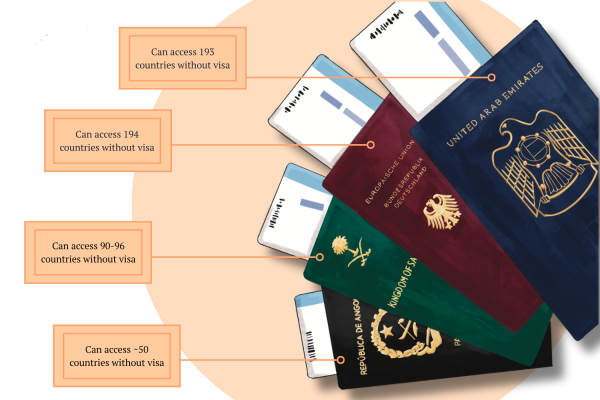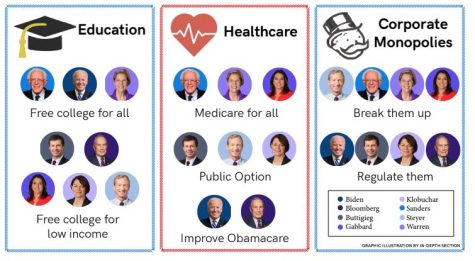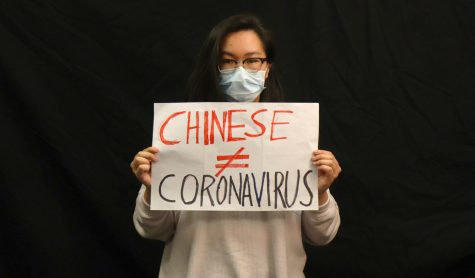Uncovering the effect of race on college admissions
Asian-American applicants sue universities over discrimination
No college application is complete without questions about an applicant’s demographics. In some cases, listing one’s race does not come lightly due to policies that limit the number of enrolled applicants based on ethnicity and race. For some students, checking the box that indicates Asian origins has made them feel stressed and anxious, as they believe that doing so could have a largely detrimental impact on their chances for admission.
In May 2015, Students for Fair Admissions, a nonprofit group that believes that classifications and preferences toward a certain race in college admissions are unnecessary and unconstitutional, filed a lawsuit against Harvard University with allegations that the university was discriminating against Asian-American applicants. The organization had backed up its claim using statistics to show how an applicant’s race contributes to whether or not the applicant gets accepted into Harvard and how being Asian reduces one’s chances of getting accepted. The Center for Equal Opportunity, a non-profit organization that specializes in Affirmative Action, immigration and bilingual education, published a study of college enrollment data from fall 2016 that outlined how universities that did not consider race, like Caltech, had more than 40 percent Asian American enrollment, while Harvard consistently enrolled less than 20 percent despite a growing Asian American community.
Affirmative Action is a program that the U.S. government takes part in to help increase diversity on college campuses. Originally established by President Lyndon B. Johnson, Affirmative Action provides historically discriminated minority groups, like African Americans and Hispanics, the opportunities toward success by leveling the playing field for all Americans. The policy promotes accessible education and supports employment of these groups. It seeks to bridge inequalities in the access of education and employment and pay while promoting diversity.
Similar allegations to the Harvard lawsuit were also raised against other Ivy League universities, and while the charges against Brown University and Dartmouth College were dropped due to insufficient evidence, the investigation of Yale University remains. Both Harvard and Yale University defended themselves against the allegations by stating that their application processes are holistic, meaning that they consider factors beyond test scores and GPA, such as academic achievement and demonstrated leadership.
“Most colleges strive for diversity in every shape such as geographic diversity, cultural diversity, religious diversity and diversity of experiences, like being a first generation college student, versus someone whose family has a longstanding history of [attending college in the U.S.],” said guidance counselor Malissa Goldstein. “And that’s because students from different backgrounds are going to bring different perspectives to the college setting, so that they can learn and grow from one another.”
Colleges value racial diversity on their campuses, as it allows their students to explore various cultures and interact with peers of different identities and backgrounds. The American Council on Education, the nonprofit major coordinating body for all the nation’s higher education institutions, states that students “learn from those whose experiences, beliefs, and perspectives are different from [their] own, and these lessons can be taught best in a richly diverse intellectual and social environment.” A culturally diverse environment allows for a stronger development of an individual’s ethnic identity, helping students achieve of their goals for a college education.
“University of California, San Diego (UCSD) is more diverse than Lynbrook, which has been good for me to get other people’s perspectives and opinions on various things,” said Lynbrook alumnus Sahil Khan, a current student at UCSD. “To hear stories of my peers working two jobs or doing odd-jobs to raise enough money to pay tuition is really eye-opening. It’s been a huge part of my college experience and I think that’s important to be a part of every college experience.”
Affirmative Action may also be contributing to discrimination in certain cases. In Regents of the University of California v. Bakke, Allan Bakke, a white man, was rejected both times when he applied to the University of California Medical School at Davis, despite how his college GPA and test scores exceeded those of all of the minority students admitted in the two years he applied. After this case, Affirmative Action was no longer considered in the admissions process for California’s public universities. Nevertheless, the program is still used by many private universities; it is considered constitutional as long as universities are taking racial background into account to create more diverse learning environments for the benefit of their students.
“The whole point of Affirmative Action is to provide applicants with equal chances of admission,” Khan said. “Families of a higher socioeconomic class often have the money to spend on SAT classes, PSAT classes and college consultants while other minority races may not have access to those kind of resources.”
Some Asian-Americans believe that Affirmative Action works against them even though they are also minorities who have faced hardships in the U.S. For example, the Congressional Exclusion Act, which prohibited immigration of Chinese laborers and the Japanese-American Internment during World War II, when Japanese Americans were forced to relocate and were incarcerated in concentration camps, have impacted many Asian-Americans. The Harvard lawsuit has gained national attention due to Asian- Americans arguing against a policy which is harming them when it is meant to benefit them.
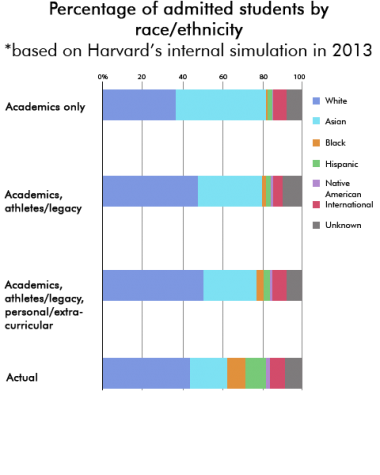
“No Longer Separate, Not Yet Equal,” a book by two Princeton University sociologists, Thomas Espenshade and Alexandra Radford, showed that Asian students would need to score higher on standardized tests such as the SAT and ACT in order for them to have the same chance of admission to top universities as Caucasian students. For example, on the SAT, they would need to score 140 points higher.
“Because Asians are seen as the model minority, I feel that colleges sometimes group us by viewing us all as well-rounded and studious applicants,” said senior Heather Kong. “So colleges may not feel like they’re getting as much diversity when they have a bunch of Asian-Americans who are all perceived as the same.”
Affirmative Action has been a controversial topic over the years. Supporters of Affirmative Action have said that Affirmative Action helps reach out to groups that are underrepresented and compensate for America’s history of racial, social and economic oppression, while critics have said that Affirmative Action is hypocritical as trying to level out the playing field among ethnicity would produce the opposite result as it would favor one group over another, basing admissions on racial preference rather than academic merit.
Students for Fair Admissions believes that a colorblind admissions process would be more equitable, saying that any consideration of race itself is discrimination. The organization hopes to remove any indication of one’s race in the student’s application packet, maintaining that through this proposal, it is definite that colleges would admit students not based on the student’s race, but rather on the student’s individual merit.
If this were the case, anything related to a student’s ethnicity or culture would have to be censored. Yet, cultural identity is often discussed in many college essays, so having that censorship would silence the stories of those who have been shaped by race, thus preventing students from sharing stories that are essential to their identity. Furthermore, people who oppose the Students of Fair Admissions’ proposal have said that racial and cultural background is vital to understanding one’s identity. They have stated that this kind of censorship is extremely hard to achieve, if not impossible.
“There are other clues on applications, and sometimes, those just give that information [race] away.,” Goldstein said. “Something as simple as your name, or organizations that students are part of already identifies their race.”
For the Students for Fair Admissions v. Harvard case, it is highly likely that the case will reach the Supreme Court as each appeal brings the case closer to being presented before the Supreme Court. Whether or not this will occur is uncertain, but one thing is sure: the lawsuits have pushed Harvard to reflect upon its admission process.
“I think colleges need to better define these other qualities that they’re looking for because when you leave them subjective and vague, that’s where part of the frustration comes from,” Goldstein said.
Whether it be through lawsuits like that against Harvard or through general discussions about college applications, the debate on policies that place race-based quotas on enrollment will continue. Advocates of this policy argue that it ensures equality to the college application process while critics maintain that it simply furthers discrimination. With both sides presenting justified arguments, it is up to people to decide where they stand on this issue for themselves.

Srinidhi is a rising senior and the Web Editor this year. Through her time on the Epic she's come to love all aspects of journalism (especially video-journalism)....
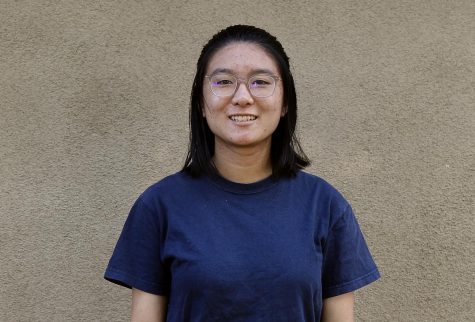
Rachel is a senior and a Design Editor for the Epic. In her free time, she enjoys reading novels and watching movies and TV shows. Some of her favorites...






























































